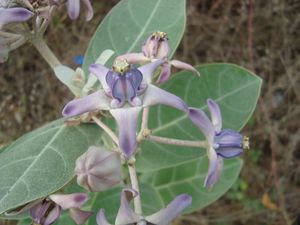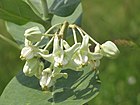Note: This is a project under development. The articles on this wiki are just being initiated and broadly incomplete. You can Help creating new pages.
Difference between revisions of "Calotropis gigantea - Arka plant"
(→External Links) |
|||
| Line 1: | Line 1: | ||
[[File:"Calotropis flower".JPG|thumb|right|'' Sadapushpa'', ''Mandara'', ''Calotropis flower'']] | [[File:"Calotropis flower".JPG|thumb|right|'' Sadapushpa'', ''Mandara'', ''Calotropis flower'']] | ||
| − | '''Calotropis procera | + | '''Calotropis procera''' is a large shrub growing to 4m tall. It has clusters of waxy flowers that are either white or lavender in color. |
| − | |||
==Uses== | ==Uses== | ||
| − | {{Uses|Rheumatism}}, {{Uses|Painful joints}}, {{Uses|Skin blemishes}}, {{Uses|Leucoderma}}, {{Uses| | + | {{Uses|Rheumatism}}, {{Uses|Painful joints}}, {{Uses|Skin blemishes}}, {{Uses|Leucoderma}}, {{Uses|Vitiligo}}, {{Uses|Piles}}, {{Uses|Pain in ears}}<ref name="Uses"/> |
==Parts Used== | ==Parts Used== | ||
| Line 9: | Line 8: | ||
==Chemical Composition== | ==Chemical Composition== | ||
| − | The milky sap contains a complex mix of chemicals, some of which are steroidal heart poisons known as "cardiac aglycones" | + | The milky sap contains a complex mix of chemicals, some of which are steroidal heart poisons known as "cardiac aglycones".<ref name="Chemical Composition"/> |
==Common names== | ==Common names== | ||
| Line 36: | Line 35: | ||
==Identification== | ==Identification== | ||
===Leaf=== | ===Leaf=== | ||
| − | {{Leaf|Simple|Opposite|Elliptic-ovate to obovate, greyish-green in colour and have entire margins, relatively thick (5-30 cm long and 4-15 cm wide) with a cordate leaf base. Secondary veins 5-7 pairs | + | {{Leaf|Simple|Opposite|Elliptic-ovate to obovate, greyish-green in colour and have entire margins, relatively thick (5-30 cm long and 4-15 cm wide) with a cordate leaf base. Secondary veins 5-7 pairs}}<ref name="Leaf"/> |
===Flower=== | ===Flower=== | ||
| − | {{Flower| | + | {{Flower|Borne in clusters|15-25 mm across|White or pinkish|Five|Flowering occurs mostly during winter}} |
===Fruit=== | ===Fruit=== | ||
| − | {{Fruit| | + | {{Fruit|Large|6-12 cm long and 3-7 cm wide||These fruit have thick and spongy skins which split open at maturity|Numerous brown, flattened seeds}} |
===Other features=== | ===Other features=== | ||
| Line 54: | Line 53: | ||
==How to plant/cultivate== | ==How to plant/cultivate== | ||
| − | Succeeds in the drier tropics. Most commonly found in areas of the tropics with a specific dry season, at elevations up to 1,000 metres<ref name="How to plant/cultivate"/> | + | Succeeds in the drier tropics. Most commonly found in areas of the tropics with a specific dry season, at elevations up to 1,000 metres.<ref name="How to plant/cultivate"/> |
==Commonly seen growing in areas== | ==Commonly seen growing in areas== | ||
| Line 61: | Line 60: | ||
==Photo Gallery== | ==Photo Gallery== | ||
<gallery class="left" caption="" widths="140px" heights="140px"> | <gallery class="left" caption="" widths="140px" heights="140px"> | ||
| − | |||
File:Starr 010701-9001 Calotropis procera.jpg|''Calotropis procera'' fruit | File:Starr 010701-9001 Calotropis procera.jpg|''Calotropis procera'' fruit | ||
File:Calotropis giganteaRHu3.JPG|Buds | File:Calotropis giganteaRHu3.JPG|Buds | ||
File:C. gigantea.JPG|Leaves | File:C. gigantea.JPG|Leaves | ||
File:Starr 070730-7945 Calotropis gigantea.jpg|Floral tassels made from ''Calotropis'' flowers. | File:Starr 070730-7945 Calotropis gigantea.jpg|Floral tassels made from ''Calotropis'' flowers. | ||
| − | |||
</gallery> | </gallery> | ||
Revision as of 11:29, 8 April 2020
Calotropis procera is a large shrub growing to 4m tall. It has clusters of waxy flowers that are either white or lavender in color.
Contents
- 1 Uses
- 2 Parts Used
- 3 Chemical Composition
- 4 Common names
- 5 Properties
- 6 Habit
- 7 Identification
- 8 List of Ayurvedic medicine in which the herb is used
- 9 Where to get the saplings
- 10 Mode of Propagation
- 11 How to plant/cultivate
- 12 Commonly seen growing in areas
- 13 Photo Gallery
- 14 References
- 15 External Links
Uses
Rheumatism, Painful joints, Skin blemishes, Leucoderma, Vitiligo, Piles, Pain in ears[1]
Parts Used
Roots, Bark, Flowers, Leaves, Latex.
Chemical Composition
The milky sap contains a complex mix of chemicals, some of which are steroidal heart poisons known as "cardiac aglycones".[2]
Common names
| Language | Common name |
|---|---|
| Kannada | Ekka, Ekkadagida, Ekkegida |
| Hindi | Aak, Akavana, Madar |
| Malayalam | Erikku |
| Tamil | Erukku, Vellerukku |
| Telugu | Jilledu |
| Marathi | Rui |
| Gujarathi | Aakado |
| Punjabi | Ak |
| Kashmiri | Vasa |
| Sanskrit | Bhaanu, Ravi, Tapana, Arka |
| English | Aakado |
Properties
Reference: Dravya - Substance, Rasa - Taste, Guna - Qualities, Veerya - Potency, Vipaka - Post-digesion effect, Karma - Pharmacological activity, Prabhava - Therepeutics.
Dravya
Rasa
Tikta (Bitter), Katu (Pungent)
Guna
Laghu (Light), Sara, Snigdha
Veerya
Ushna (Hot)
Vipaka
Katu (Pungent)
Karma
Vatahara, Kaphahara, Bhedana, Deepana, Kshamighna
Prabhava
Habit
Identification
Leaf
| Kind | Shape | Feature |
|---|---|---|
| Simple | Opposite | Elliptic-ovate to obovate, greyish-green in colour and have entire margins, relatively thick (5-30 cm long and 4-15 cm wide) with a cordate leaf base. Secondary veins 5-7 pairs |
Flower
| Type | Size | Color and composition | Stamen | More information |
|---|---|---|---|---|
| Borne in clusters | 15-25 mm across | White or pinkish | Five | Flowering occurs mostly during winter |
Fruit
| Type | Size | Mass | Appearance | Seeds | More information |
|---|---|---|---|---|---|
| Large | 6-12 cm long and 3-7 cm wide | These fruit have thick and spongy skins which split open at maturity | Numerous brown, flattened seeds | {{{6}}} |
Other features
List of Ayurvedic medicine in which the herb is used
- Vishatinduka Taila as root juice extract
Where to get the saplings
Mode of Propagation
How to plant/cultivate
Succeeds in the drier tropics. Most commonly found in areas of the tropics with a specific dry season, at elevations up to 1,000 metres.[4]
Commonly seen growing in areas
Tropical area, Indian subcontinent.
Photo Gallery
References
External Links
- Ayurvedic Herbs known to be helpful to treat Rheumatism
- Ayurvedic Herbs known to be helpful to treat Painful joints
- Ayurvedic Herbs known to be helpful to treat Skin blemishes
- Ayurvedic Herbs known to be helpful to treat Leucoderma
- Ayurvedic Herbs known to be helpful to treat Vitiligo
- Ayurvedic Herbs known to be helpful to treat Piles
- Ayurvedic Herbs known to be helpful to treat Pain in ears
- Herbs with Roots used in medicine
- Herbs with Bark used in medicine
- Herbs with Flowers used in medicine
- Herbs with Leaves used in medicine
- Herbs with Latex used in medicine
- Herbs with common name in Kannada
- Herbs with common name in Hindi
- Herbs with common name in Malayalam
- Herbs with common name in Tamil
- Herbs with common name in Telugu
- Herbs with common name in Marathi
- Herbs with common name in Gujarathi
- Herbs with common name in Punjabi
- Herbs with common name in Kashmiri
- Herbs with common name in Sanskrit
- Herbs with common name in English
- Habit - Large shrub
- Index of Plants which can be propagated by Seeds
- Index of Plants which can be propagated by Cuttings
- Index of Plants which can be propagated by Layering
- Herbs that are commonly seen in the region of Tropical area
- Herbs that are commonly seen in the region of Indian subcontinent
- Ayurvedic Pharmacopedia of India
- Herbs
- Ayurvedic herbs that don't have seed photos
- Apocynaceae




